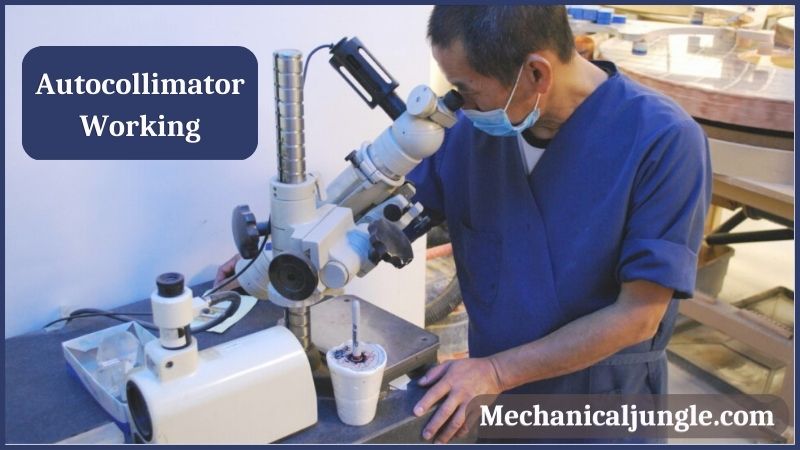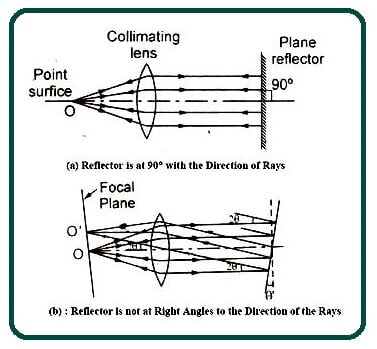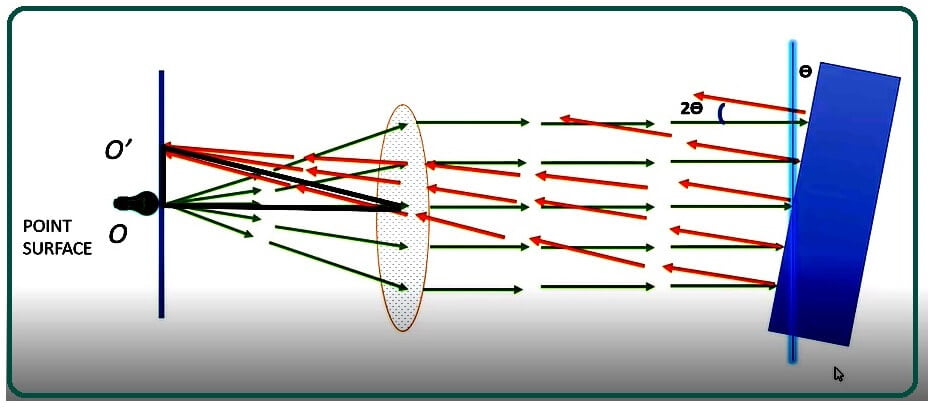
Autocollimator Working:

In actual practice, the work surface whose tilt is to be obtained forms the reflective surface, & the displacement x is measured by a precisions microscope that is directly calibrated to the tilt values of inclinationΘ.
The optical system of the autocollimator is shown in fig.; the target wires are illuminated with an electric bulb and serve as a source of light because it is not convenient to visualize the reflected image of a point and then measure the displacement x properly.
After being reflected from the surfaces being measured, the image of the illuminated wire is formed in the same plane as the wire.
The eyepiece system containing the micrometer microscope apparatus consists of a pair of setting lines, which can be used to measure the displacement of the image by setting it to the original cross lines and then moving over them to the image.
Typically, calibration is supplied with the instruments. thus, the angle of inclinations of the reflecting surface towards the micrometer scale can be read directly. Autocollimators are fairly accurate and can read up to 0.1 seconds, and can be used for distances of up to 30 meters.
What Is the Autocollimator Method?
The autocollimator is an optical instrument used to measure small angular differences. This device is very sensitive to changes in angles and provides a very accurate measurement of angular difference.
It is basically a combination of an infinity telescope and a collider. Autocollators are mainly used to align optical components and measure the optical and mechanical deflection.
Principle of Autocollimator:

The two main principles used in autocollimators are (a) projection and refraction of a beam parallel to light by a lens (b) the change in the direction of the reflected angle on the plane is accompanied by a change in the angle of reflection of the surface.
To understand this, let us imagine a convergent lens with a point source of light o on our theory, as shown in fig.; a. When a beam of light strikes a flat reflective surface, one part of the beams is absorbed, and the other part is reflected back.
If the angle of incidence is zero, that is, incident rays fall perpendicular to the reflective surface, then the reflected rays reproduce the original path. When the reflective plane is tilted at fixed angles, the total angle through which the light is deflected is twice the angle through which the mirror is tilted.
Thus, alternatively, if the incident rays are not at right angles to the reflective surface, they can be brought to the focal plane of the light sources, reflecting the reflecting plane at half the angle of reflection as shown in fig. b.

Now, from the diagram, oo’ = 2θ × f = x, where f is the focal length of the lens. Thus, by measurings, the linear distance x, the inclination of the reflecting surface θ can be determined.
The position of the final image does not depend upon the distance of the reflector from the lens. If, however, the reflector is moved too long, the reflected ray will then completely miss the lens, and no image will be formed.
Parts of Autocollimator:
Six parts of the autocollimator:-
- Light Source.
- Reflecting Surface.
- Diverging Lens.
- Beam Splitter.
- Target Graticule.
- Micrometer microscope
#1. Light Source
the light source is used to generate the light rays so that it reaches the reflectors.
#2. Reflecting Surface
it is the surfaces that act as a workpiece for the autocollimators. Using the autocollimator, the angles of tilt of this reflecting surface is to be measured. It reflects the parallels of light rays coming through an objective lens.
#3. Diverging Lens
the diverging lens, which is also knowns as the objective lens, is used to parallelize the light rays coming through the beam’s splitter so that parallel light rays reach the reflectors.
#4. Beam Splitter
the beam splitter is used to split the light rays and direct them towards the objective lens.
#5. Target Graticule
The light rays, after getting reflected, reached this target graticule, and the distance between the incident & reflected ray is traced in this target’s graticules.
#6. Micrometer Microscope
it is used to see points of incidents and reflected rays in the target graticules clearly and measure the distance between them.
Working of Autocollimator:

In autocollimators, the reflective surface is the surface whose inclination is to be measured using this instrument. The distance between the source of light & the reflected ray in the focal plane is measured using a micrometer microscope.
First, the light source is illuminated, & the rays of the light line are extracted from the intersection points of the cross-line target gratitude, which is placed in the focal plane of the objective lens. After that, the beam of the beam reaches the beam splitter, and the v-ray beam is the gate that will direct the light rays towards the objective lens.
The objective lens will parallel the light rays, & the light rays will move toward the reflectors.
Now there can be two cases:
Case 1: The reflector is perpendicular to the ray of light.
- When the reflected light rays reach the reflector, and the reflector is perpendicular to the light rays, the light rays will reflect back to their original path.
- These light rays are then brought to focus in the plane of the target’s graticule, coincident with the intersection of the cross lines of the grillage.
- Some part of the reflected light passes directly through the beam splitter, and therefore the image of the return of the target crossline is therefore visible through the eyepiece, thus acting as a telescope centred at infinity.
Case 2: The reflector is tilted at some angle.
- If the reflector is tilted at an angle, the reflected light rays from the reflector double the tilt angle. After reflection, the light rays are focused in the plane of the target granule but linearly displaced from the intersection of the crossline by a distance of 2 * (angle of inclination) (focal length of the objective lens).
- The linear displacements of the graticule image are measured by an eyepiece graticule and a micrometer microscope or an electronic detector system that uses a visual or digital autocollimator.
- Most autocollimators are calibrated so that the distance measured in the angle of inclination does not need to be changed. It converts to the autocollimator itself, and the tilt angle can be read directly into the autocollimator.
- The factors responsible for the autocollimator’s basic sensitivity and angular measurement range are the focal length and effective aperture.
Types of Autocollimator:
Two types of autocollimators:-
- Visual Autocollimator.
- Digital Autocollimator.
#1. Visual Autocollimator
In the visual autocollimator, the angle of inclination of the reflecting surface is measured by observing graduation through an eyepiece. As the focal length of the visual autocollimators increases, the angular resolution increases, & the field of view decreases.
#2. Digital Autocollimator
In the digital autocollimator, micrometer adjustment is provided for the setting, but the coincidence of setting the static and target image is detected photo-electrically. This autocollimator is used in the lab. It has very high precision, provides real-time measurement, and is very user friendly.
Applications of Autocollimator:
Here, the different Applications of autocollimators are as follows
- Direct testing of machine tool slides.
- Measuring very small angles.
- Checking for similarities.
- Checking the base of the column.
- Checking the flatness of bed plates and surface tables.
- Measuring very small displacement.
- Checking for small linear displacement.
Advantages of Autocollimator:
Here, the different Advantages of autocollimator are as follows
- It has very high accuracy.
- It can measure a wide range of angles.
- It is very easy to install and operate.
- Calibration surpasses international standards.
- It can be used to visually or electronically view the result, i.e., on the computer screen.
- A wide range of available accessories and levels.
Disadvantages of Autocollimator:
Here, the different Disadvantages of autocollimator are as follows
- Maintenance is required regularly.
- It is time-consuming.
- It requires sample cutting and processing for tracing by the detector.
FAQ: Autocollimators
What Is an Autocollimator?
An autocollimator is an optical instrument used to measure small angular differences with high accuracy. It combines the functions of an infinity telescope and a collimator, primarily used to align optical components and measure optical and mechanical deflection.
How Does an Autocollimator Work?
An autocollimator works by projecting a beam of light onto a reflective surface. The reflected light returns through the same optical system and forms an image that can be measured. The displacement of this image is directly related to the tilt angle of the reflective surface.
What Are the Main Components of an Autocollimator?
The main components of an autocollimator are:
- Light Source
- Reflecting Surface
- Diverging Lens
- Beam Splitter
- Target Graticule
- Micrometer Microscope
What Are the Principles Behind the Operation of an Autocollimator?
The operation of an autocollimator is based on two principles:
- Projection and refraction of a beam of light by a lens.
- The change in the direction of the reflected angle on the plane corresponds to the tilt of the reflective surface.
How Accurate Are Autocollimators?
Autocollimators are highly accurate instruments that can measure angular differences with a precision of up to 0.1 seconds of arc.
What Are the Different Types of Autocollimators?
There are two main types of autocollimators:
- Visual Autocollimators: Measure angles by observing graduations through an eyepiece.
- Digital Autocollimators: Use photoelectric detection for high precision and real-time measurement.
What Are the Applications of Autocollimators?
Autocollimators are used in various applications, including:
- Direct testing of machine tool slides
- Measuring very small angles
- Checking for similarities
- Inspecting the base of columns
- Verifying the flatness of bed plates and surface tables
- Measuring very small displacements
What Are the Advantages of Using an Autocollimator?
The advantages of using an autocollimator include:
- High accuracy
- Wide range of measurable angles
- Easy installation and operation
- Calibration to international standards
- Ability to view results visually or electronically
- Availability of a wide range of accessories
What Are the Disadvantages of Using an Autocollimator?
The disadvantages of using an autocollimator are:
- Regular maintenance required
- Time-consuming process
- Requires sample cutting and processing for tracing by the detector
How Is the Angle of Inclination Measured with an Autocollimator?
The angle of inclination is measured by projecting light onto the reflective surface and analyzing the displacement of the reflected light image in relation to the original cross lines using a micrometer microscope or an electronic detector system.
Can an Autocollimator Measure the Tilt of Any Reflective Surface?
Yes, an autocollimator can measure the tilt of any reflective surface as long as it is capable of reflecting the projected light beam back through the optical system.
How Does the Focal Length of the Objective Lens Affect the Performance of an Autocollimator?
The focal length of the objective lens affects the sensitivity and angular measurement range of the autocollimator. A longer focal length increases angular resolution but decreases the field of view.

